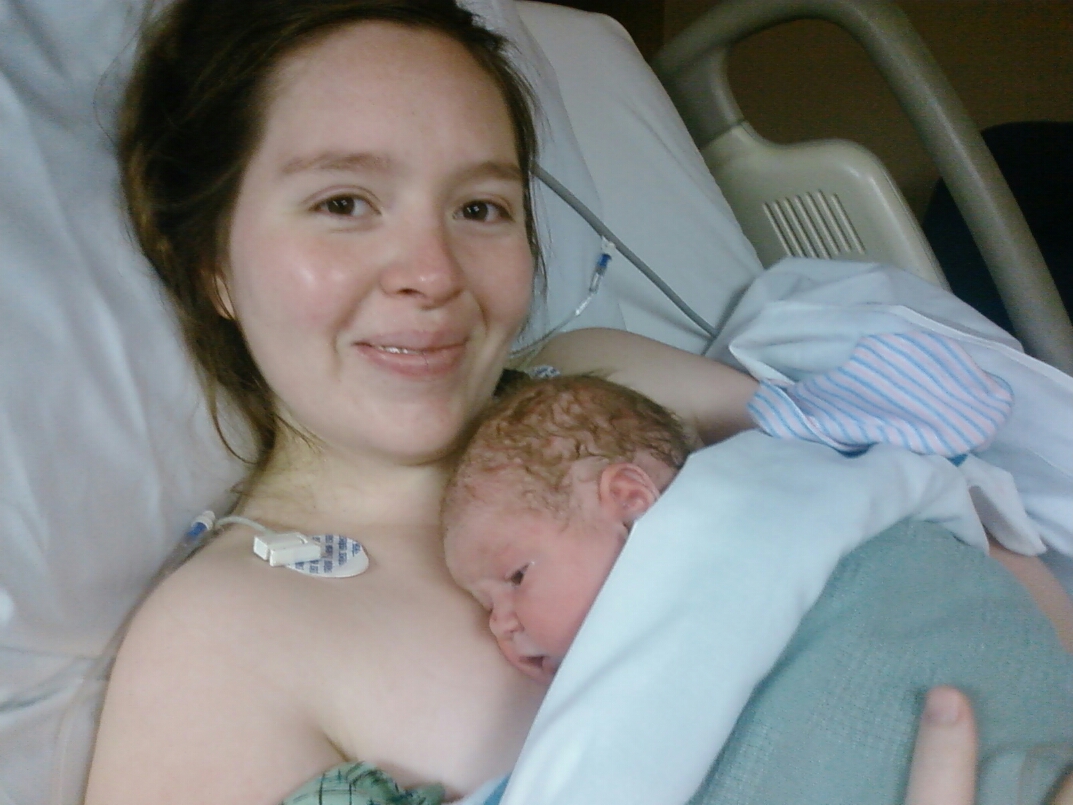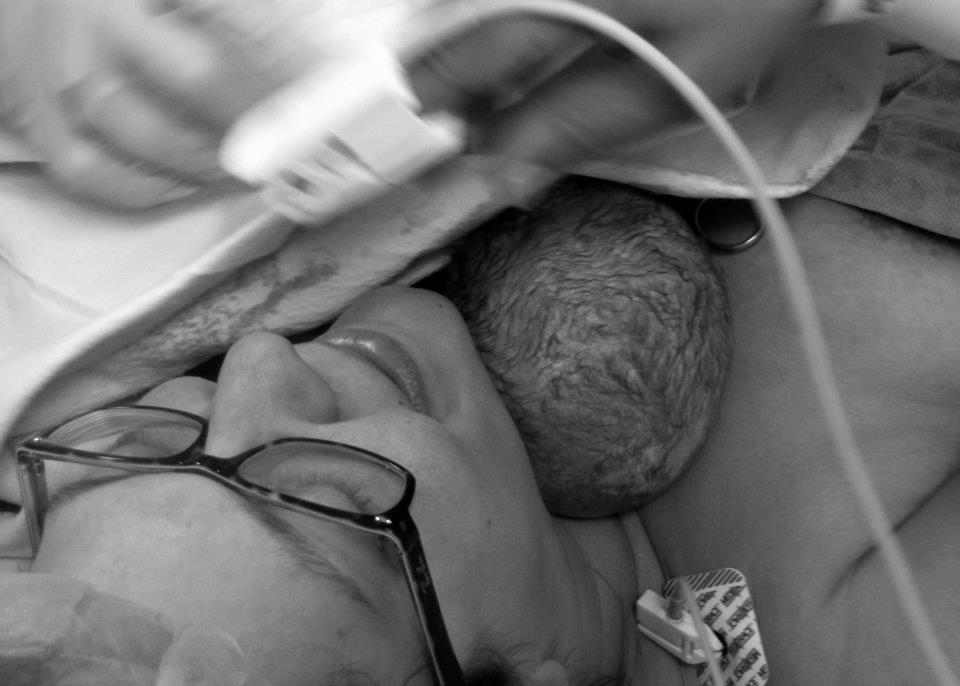--I had to share this article, it is such a beautiful birth story showing that the an unexpected birth plan can still turn out the be a wonderful experience.
The article is from ImprovingBirth.org
A Family-Centered Cesarean: Taking Back Control of My Son’s Birth
So, what happens if you are completely committed to “going natural” and things don’t work out? How do you deal with being told, “This baby is at risk. We need to deliver via cesarean”?
All that matters is a healthy baby – you just need to get over it…right?
Get over it? Just like that? Of course the ultimate goal is a healthy baby, and of course you are going to agree to the cesarean for the well-being of your child. But that doesn't mean it’s going to be easy to let go of the experience you've been envisioning for nine months, and it doesn't mean you don’t have the right to grieve that loss.
It can be extremely empowering to take back the birth experience – to decide where and in what position you will labor, to tell the delivery staff, “I will not lie on that bed and push my baby out, thank you very much,” and to place your baby on your bare chest immediately after he or she is born to nurse and begin your new life together. But once a cesarean enters the picture, the ability to maintain any power over your birth experience flies out the window…or does it?

Immediate skin-to-skin for Kelsey and her son Finn while still on the operating table as surgery finishes up. “He was silent, just stared at me, and then rooted around to nurse,” says mom. So precious!
My partner Sean and I had been planning a natural childbirth. We established our prenatal care with a midwifery practice, we took a six-week natural childbirth class, we attended a labor workshop, we read Ina May Gaskin’s Guide to Childbirth, we watched videos of water births, we hired a doula, we had a birth plan – we were set. Our due date came and went, but that’s pretty standard for first babies, so no one was worried. I had had a relatively easy pregnancy, the baby was healthy, I was healthy, so all seemed fine.
At 41 weeks I went in for a routine ultrasound just to make sure my fluid levels still looked good. I sat in the chair, the tech gooped up my belly with gel, and she placed the ultrasound probe on my skin.
“Oh, so I see we have a breech baby.”
“Huh? We don’t have a breech baby!”
“Yes, you do – see? This is the head right here.”
WHAT????!!!
I had just been to see my midwife the week before, and she didn’t think there was anything abnormal about the baby’s position. I immediately started to cry and asked, “What does this mean? Will I have to have a c-section? Isn’t there some sort of turning procedure that can be done?” The ultrasound tech told me the obstetrician would come and talk to me and that, yes, if the baby wasn’t too big, they might be able to try the External Cephalic Version (ECV) turning procedure, but they could also just go ahead and schedule a cesarean for me since I was already at 41 weeks.
“I really don’t want a cesarean,” I told her. “We really want to have a natural childbirth. I’d really like to try to turn this baby.”

One happy mommy: Donita and Alejandra bonding after birth
Our baby was estimated to be 7 pounds 14 ounces (we later learned he was about a pound larger than this). Since they thought he was fewer than 8.5 pounds, the obstetrician said he could make an attempt at ECV. He told me to go ahead and schedule the procedure for the next day. If the ECV attempt didn’t work, he told me, he would go ahead and deliver our baby via cesarean that same day.
I felt like I had been hit by a truck. It was just too much to process all at once – to find out that our baby was breech, to schedule an appointment for this weird medical procedure, and to swallow the idea that if the ECV didn’t work, I was going to have my baby surgically removed the next day. It seemed that not only were all of our plans flying out the window, but so was all of our power.
I scheduled the appointment and then went to see my midwife. I felt some relief when she told me that, as long as the baby was not showing signs of distress, I absolutely did not have to have a cesarean the next day if the ECV didn’t work. I was only one week past my due date; I had until the following Monday (two weeks past my due date) to try to get this baby to turn. I was so grateful to have that extra window. I felt like we got back a little bit of that power we had lost.
We went to the hospital the next morning at 6:30 am, and after waiting 3.5 hours, the ECV was performed. It was excruciatingly painful, and, unfortunately, it didn’t work. They monitored the baby for two hours after the procedure was attempted, and we were cleared to go home. We were very disappointed the procedure didn’t work, but we were grateful to have a little extra time to try some other turning techniques.

With careful planning and support of their care team, this family had a gentle, joyful, family-centered cesarean at Baystate Franklin Medical in Greenfield, Massachusetts. Mama waited until labor began to go into surgery; after birth, she got her wet baby skin-to-skin on her chest, and the obstetrician even
milked the baby’s cord to send her home with the placenta!
Credit: Marissa Potter at www.BellyfullBirth.com
And try we did. Over the course of the next four days, I had two “Turn-Baby-Turn” Massages; four visits to the chiropractor for the Webster Technique adjustment (
video here); lots of forward-leaning inversions; and a crazy set-up that involved an ironing board propped on an incline against the couch, me lying on the ironing board with my head at the floor and feet up at the top of the board, a bag of frozen blueberries at the top of my belly, a heating pad at the bottom of my belly, and a flashlight shining and music playing between my legs.
On Friday, we went in for another ultrasound and learned that, despite all of our efforts, our baby was still breech. Reluctantly, we scheduled the cesarean for Monday morning.
At this point, I reached out to other women I knew who had planned a natural birth but ended up needing to deliver via cesarean. I asked for their advice – what did they do (or what did they wish had been done) to make their birth experience more in line with what they had hoped for?
I am so glad I asked. I learned that, even with a cesarean, it is possible to retain some control over the birth experience. One friend in particular, who had to have an emergency cesarean after planning a natural homebirth (twice), really helped us identify certain requests that we could make, requests that gave us a taste of those aspects of the natural birth that were most important to us. She also sent me
this article, which is about strategies to make cesareans more woman-centered.
On Saturday morning (two days before the cesarean was scheduled), my water broke and I went into labor. We went to the hospital, and, thanks to the bagel I had eaten a half hour before, I had to wait for six hours for the cesarean.

From the U.K.: baby went right to mom’s chest and had delayed cord clamping, as well.
I felt like it was such a blessing to get to experience natural labor for those six hours!Laboring is good for the baby, and it was good for me emotionally. While they were preparing me for surgery, I met with the obstetrician and the anesthesiologist and made a few requests for my cesarean. They agreed to all of my requests, and I had a much more fulfilling birth experience because of those few little things. Here’s what I asked for:
- I asked them to drop the surgical curtain down a little bit and to and hold our baby up after they pulled him out so I could see him immediately after he was born. I couldn’t see the actual surgery (thankfully!), but I was able to see our son in the first seconds of his life.
- I requested that they put our baby on my chest in the operating room while they were sewing me back up. They did have to wrap him up in blankets before they could put him on my chest because they keep the operating room so cold (to prevent bacterial growth), but at least I was able to see him and touch him and kiss him before they took him to be weighed and measured.
- I asked, in addition to my partner, to have my midwife in the operating room with me (which I was glad to learn was standard operating procedure). I gave my midwife a camera and asked her to take pictures of the cesarean. This was wonderful – the pictures were amazing, and having the documentation of our baby’s first moments outside of the womb helped me to connect to the birth experience and begin to feel like our experience was a real birth.
- I requested that my partner be able to stay with our baby through all of the post-birth measurements and procedures.
- I requested that I be allowed to breastfeed our baby as soon as possible. He was brought to me in the recovery room within an hour of his birth.
- I requested that my doula be permitted to sit with me in the recovery room so that I had someone to keep me company while I waited for my partner and our baby to return from the nursery.
While my partner and I weren’t able to have the birth experience we had been envisioning, our son’s birth was still special. I think the reason it didn’t end up being a traumatic experience for us was because we were able to retain some power over the process. In many cases, there is the opportunity to make requests of the surgical team, but we often don’t realize we are “allowed” to ask.
ASK.
Our thanks to Shannon in Lexington, Kentucky, for contributing this story!






